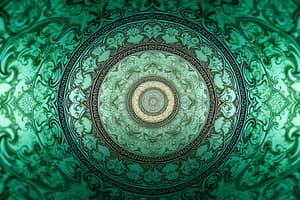Podcast
Questions and Answers
What is the nature of the image formed when the object is placed beyond the center of curvature (C) of a concave mirror?
What is the nature of the image formed when the object is placed beyond the center of curvature (C) of a concave mirror?
Where is the position of the image formed when the object is at the focus (F) of a concave mirror?
Where is the position of the image formed when the object is at the focus (F) of a concave mirror?
Which type of mirror positioning results in an enlarged and virtual image?
Which type of mirror positioning results in an enlarged and virtual image?
What size does the image have when the object is placed between the focal point (F) and the mirror?
What size does the image have when the object is placed between the focal point (F) and the mirror?
Signup and view all the answers
What are concave mirrors commonly used for?
What are concave mirrors commonly used for?
Signup and view all the answers
In the activity with a convex mirror and a pencil, what does an upright image of the pencil indicate?
In the activity with a convex mirror and a pencil, what does an upright image of the pencil indicate?
Signup and view all the answers
When forming an image using a concave mirror, if the object is placed beyond the focal point, what type of image is formed?
When forming an image using a concave mirror, if the object is placed beyond the focal point, what type of image is formed?
Signup and view all the answers
What is one characteristic of the image formed by a convex mirror?
What is one characteristic of the image formed by a convex mirror?
Signup and view all the answers
What happens to the size of the image when the candle is moved away from the lens?
What happens to the size of the image when the candle is moved away from the lens?
Signup and view all the answers
What is the nature of the image formed by a concave lens when the object is between focus F1 and optical centre O?
What is the nature of the image formed by a concave lens when the object is between focus F1 and optical centre O?
Signup and view all the answers
Using ray diagrams, how can lenses help determine the nature of the image formed?
Using ray diagrams, how can lenses help determine the nature of the image formed?
Signup and view all the answers
Based on the activity described, what conclusion can be drawn about a concave lens?
Based on the activity described, what conclusion can be drawn about a concave lens?
Signup and view all the answers
Study Notes
Concave Mirror
- When the object is placed beyond the center of curvature (C), the image formed is real, inverted, and smaller than the object.
- When the object is at the focus (F), the image formed is at infinity, meaning it is highly magnified and appears to be at a very large distance.
- When the object is placed between the focal point (F) and the mirror, the image formed is larger than the object.
- Concave mirrors are commonly used in telescopes, solar ovens, and satellite dishes.
Convex Mirror
- An upright image of the pencil indicates that the object is farther away from the mirror than the focal length.
- Convex mirrors always form a virtual, upright, and smaller image of the object.
Image Formation
- When the object is placed beyond the focal point, a concave mirror forms a real, inverted image.
- Convex mirrors always form an upright image.
- When a candle is moved away from the lens, the size of the image decreases.
- When the object is between focus F1 and optical centre O, a concave lens forms a virtual, upright image.
Lenses and Ray Diagrams
- Ray diagrams can help determine the nature of the image formed by a lens.
- A concave lens always forms a virtual, upright image of the object, as indicated by the activity described.
Studying That Suits You
Use AI to generate personalized quizzes and flashcards to suit your learning preferences.
Description
Test your knowledge on image formation by a concave mirror and the characteristics of images formed for different positions of the object. Questions may cover topics such as image size, image nature, and object position relative to the mirror.




